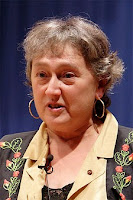 |
| Examples of eukaryotes |
The discovery that there are two
main types of living cells (prokaryotes and eukaryotes) gave rise to a
revolution in the way of classifying living things. Although (as usual)
biologists do not agree on a single classification, the following one seems
very reasonable:
1. Empire prokaryote (bacteria). DNA free in the protoplasm.
a. Kingdom eubacteria (true bacteria). They use acyl ester lipids.
b. Kingdom archaea. They use isoprenoidal-ether lipids. They include
sulphobacteria, methanobacteria and halobacteria.
2. Empire eukaryote (cells with nuclei). DNA inside the nucleus. They have a cytoskeleton.
c. Kingdom archaezoa (primitive eukaryotes). They have no organelles.
d. Kingdom protozoa (advanced unicellular eukaryotes) with symbiotic
organelles.
e. Kingdom Fungi.
f. Kingdom metaphyta (plants).
g. Kingdom of metazoa (animals).
The archaezoa (primitive eukaryotes)
are very close to the archaea, so it seems likely they came from them by
acquiring a nucleus. Recently
a possible candidate for the archaea closest to us has been discovered in the
bottom of the Arctic Ocean and given the name lokiarchaea.
 |
| Lynn Margulis |
But the most surprising eukaryotic
mystery is the origin of cellular organelles (mitochondria, peroxisomes and chloroplasts).
Since 1967, Lynn Margulis was the first to propose that this happened by
endosymbiosis. Let's see how.
Cell organelles belong to three main
types. They contain their own DNA, sometimes with striking differences in the
genetic code.
•
Mitochondria:
they carry out cellular respiration, which takes advantage of oxygen to obtain energy.
•
Peroxisomes:
they contain peroxidases and aid in the digestion of fatty acids.
•
Chloroplasts:
they perform the chlorophyll function.
Endosymbiosis asserts that organelles
were acquired successively by primitive archaezoa by means of symbiosis: first
mitochondria (bacteria capable of breathing oxygen); then peroxisomes
(gram-positive bacteria capable of generating peroxidases); eventually (after
separation of the strains that resulted in fungi and animals) some protozoa
acquired chloroplasts (they were originally autotrophic Cyanobacteria). From this
group, plants arose later.
How could this be accomplished by symbiosis?
It’s a mystery. Obviously some primitive archaezoa swallowed a bacterium
capable of breathing oxygen, in order to digest it. What happened to prevent
the prey to be digested? How could the bacterium get used to live and reproduce
inside the membrane of the archaezoa and share with it the results of its respiratory
process, which generate much more energy than anaerobic processes? Why was the
reproduction cycle of both the host cell and the symbiotic organelles get
synchronized, so that when the eukaryotic cell is divided the cellular
organelles also divide and are shared between the two daughter eukaryotic cells?
Why and how some genetic information originally contained in the organelles was
transmitted to the nucleus of the eukaryotic cell? Nobody knows just now.
Manuel Alfonseca
No comments:
Post a Comment